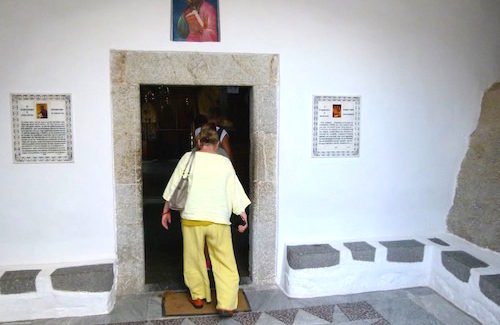Shore excursion: Visiting Patmos cave where St. John wrote Book of Revelation
The dreaded Four Horsemen of the Apocalypse. The terrifying Beast with Seven Heads. The scary opening of the Seven Seals. The Final Judgement with its brimstone vision of hell.
How could all these horrific things detailed in the Book of Revelation have been written in such a beautiful place?
Although our Celestyal Olympia cruise ship stopped for less than six hours on the island of Patmos, I was eager to visit the cave where St. John the Evangelist was said to have written the Book of Revelation, the last book in the New Testament of the Bible.
To reach Patmos, we took tender boats from the Olympia to the island, then had a short shuttle ride. We climbed winding alleyways halfway up a hill to the sacred cave. The Greek island has a population of about 3,000 and is difficult to visit except by ship.
Patmos was designated a “Holy Island” by the Greek Parliament in 1981. It also was proclaimed a World Heritage Site by UNESCO in 1999.
“St. John was exiled here from his home in Ephesus by the Roman emperor Domitian,” said tour guide Angela. “It was his punishment for preaching the gospel. One of Jesus’ disciples, St. John was more than 90 years old when he was exiled here and it was very very difficult for him.”
Sent to Patmos in 95 AD, St. John was exiled for about 18 months. Praying in a cave, St. John was said to have been visited by God with visions of what was to come to pass.
“God’s voice was so loud that it cracked the ceiling in the cave in three places,” Angela said. “It was a symbol of the Holy Trinity – God the Father, the Son and the Holy Spirit.”
Angela also pointed out a natural rock desk where St. John was said to have written Revelation and a hole in the wall where he reportedly rested his head. Another carved-out hole in the cave wall is where St. John would place his hand.
Dark and incense scented, the cave does seem to be filled with a strange yet peaceful feeling. No photos are allowed in the cave so I can’t show you what it looked like. However, I can tell you that stepping back out into the brilliant azure blue of the island sky and Aegean Sea was a relief.
After the cave, we walked to the monastery founded in 1088 by a monk named Christodoulos to honor St. John. There, black-robed monks keep an eye over the museum’s treasures – an amazing collection of icons, sacred relics, original manuscripts, and vestments embroidered with silver and gold threads and bejeweled with precious stones. Again, photos were not allowed.
Walking back down the narrow streets lined with glittering whitewashed houses, we browsed through some of the crafts and other items for sale. One of the popular gifts is the “evil eye” charm said to ward off curses. Sold often in Greece and Turkey, the bright blue eye charms are available in necklaces, rings, keychains and wall hangings.
Catching the tender back to the ship, we enjoyed a Greek barbecue by the pool for dinner. That happy event was a welcome fun finale to a day spent walking through the heavy images of St. John’s Book of Revelation.















View Recent Comments